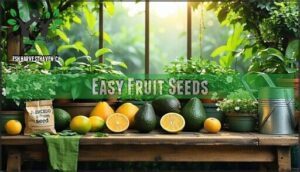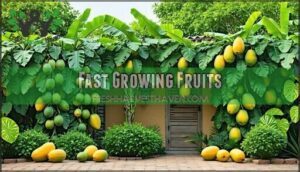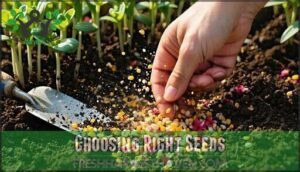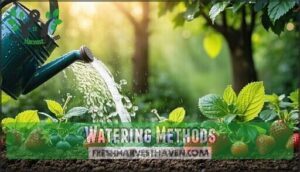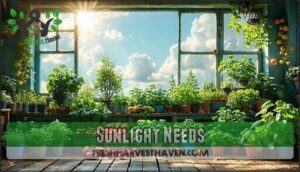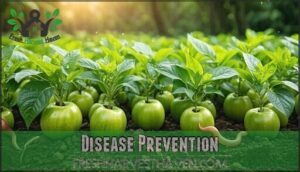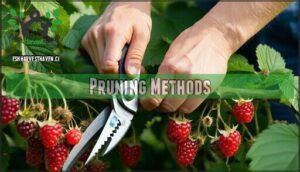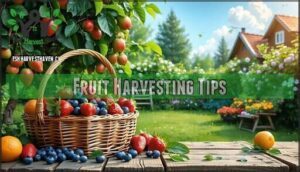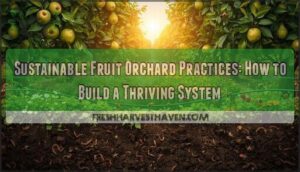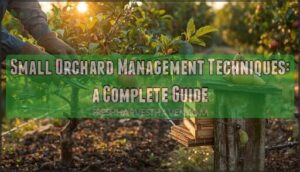This site is supported by our readers. We may earn a commission, at no cost to you, if you purchase through links.
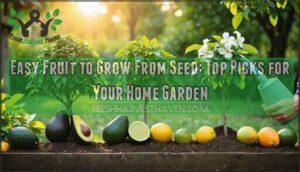
Avocados, citrus fruits, and mangoes top the list for beginners—simply clean seeds from store-bought fruit and plant them.
These varieties don’t require grafting or special techniques, making them perfect starter projects.
You’ll need well-draining soil, consistent moisture, and bright indirect light.
While patience is essential since fruit production takes 3-7 years, watching your seedlings develop into mature trees brings incredible satisfaction.
The secret lies in understanding each fruit’s unique germination requirements and providing proper care during those pivotal first months.
Table Of Contents
- Key Takeaways
- Easy Fruit Seeds
- Fast Growing Fruits
- Choosing Right Seeds
- Planting Techniques
- Fruit Seed Care
- Fruit Harvesting Tips
- Frequently Asked Questions (FAQs)
- What fruits can you grow from seeds?
- What fruits are easy to grow?
- Can you grow a fruit from a seed?
- What fruits can you grow in a small space?
- Are fruits and vegetables easy to grow?
- How do you grow fruit trees from seeds?
- What is the easiest fruit to grow from seed?
- What is the fastest growing fruit from seed?
- What seeds germinate in 7 days?
- Is a fruit or vegetable?
- Conclusion
Key Takeaways
- Start with beginner-friendly varieties – You’ll have the best success with avocados, citrus fruits, mangoes, and papayas since they don’t require grafting or special techniques and germinate easily from store-bought fruit.
- Focus on proper seed preparation – You’ll boost your success rate by cleaning seeds thoroughly, soaking them for 24-48 hours before planting, and using fresh seeds from fully ripe fruits.
- Provide optimal growing conditions – You’ll need well-draining soil with pH 6.0-7.0, consistent moisture without waterlogging, and bright indirect light or 6-8 hours of direct sunlight daily.
- Expect patience but plan for rewards – You’ll wait 3-7 years for fruit production from seed-grown trees, but you can enjoy watching your kitchen scraps transform into thriving plants and eventually homegrown fruit.
Easy Fruit Seeds
Growing your own fruit from seed is simpler than you might think, and several varieties offer excellent success rates for beginners.
You’ll find that avocados, citrus fruits, mangoes, and papayas are among the most forgiving options, requiring minimal preparation and offering quick germination in the right conditions, which makes them ideal for beginners.
Avocados
With the right germination methods, growing avocados from seed is surprisingly straightforward.
Start by removing the avocado pit from fresh fruit and trying seed soaking for 24 hours to boost success rates. The classic toothpick method works well—suspend the pit over water with the pointed end up.
Indoor avocado trees make excellent houseplants while you wait for fruit production, which typically takes 5-13 years for seed-grown varieties. Though grafting avocados produces faster results, starting seeds offers rewarding hands-on experience with diverse avocado varieties.
For superior growth, make certain the plant receives six hours of sunlight.
Citrus Fruits
Citrus fruits offer some of the easiest fruit seeds for beginning gardeners.
These citrus varieties germinate quickly when you provide warmth and consistent moisture.
Indoor citrus plants thrive in containers, making them perfect for year-round growing.
Choose proper container size and focus on fertilizing citrus regularly.
While most fruit seeds don’t produce true-to-type plants, starting seeds from oranges and lemons remains rewarding.
Consider grafting techniques later for reliable harvests from your easy fruits.
Mangoes
Growing mangoes from seed offers an exciting gardening adventure.
Transform your kitchen scraps into thriving fruit trees with seeds that practically grow themselves.
Extract fresh seeds from ripe fruit and remove the tough outer husk for faster germination. Soak seeds for 24 hours to boost success rates.
Plant in well-draining soil with temperatures between 75-86°F. Indoor mangoes work well in containers initially, though fruiting time extends 5-8 years for seed-grown trees versus grafted varieties.
- Pro tip: Mango varieties from seed won’t match the parent fruit’s flavor—think of it as nature’s surprise package with potentially unique characteristics.
Papayas
After mangoes, papayas offer another tropical delight that’s surprisingly easy to grow from seed.
These fast growing fruit trees produce nutritious results within months in warm climates.
| Papaya Varieties | Growing Indoors | Culinary Uses |
|---|---|---|
| Solo (Hawaiian) | Requires bright light | Fresh eating |
| Red Lady | Compact size preferred | Smoothies |
| Sunrise | Container-friendly | Papaya enzymes aid digestion |
| Tainung | Dwarf varieties best | Green papaya salads |
| Mexican Red | Needs warmth year-round | Meat tenderizer |
Start your fruit gardening journey by cleaning seeds thoroughly and soaking them overnight.
Plant in rich, moist soil with full sunlight for ideal germination in fruit seeds projects.
Fast Growing Fruits
When you’re enthusiastic to see results, fast growing fruit from seed can deliver impressive fruiting timelines.
Papayas lead the pack, producing fruit within six to eight months in tropical climates. Their rapid seed germination and vigorous growth make them perfect for beginner gardening projects.
Melons and passionfruit offer excellent germination speed, sprouting quickly with minimal fuss. Watermelons thrive in warm conditions, while tomatoes (technically fruits) show remarkable growth rates when started from seed.
Container options work well for dwarf lemons, which can fruit within a few years when given ample sunlight. Climate impact plays a huge role – tropical fruits like mangoes germinate fast but need consistent warmth.
For variety selection, consider your local conditions. Cold-hardy fruits require patience, while tropical varieties reward you with quicker harvests.
Soaking seeds for 24-48 hours before planting dramatically improves germination rates across most species.
To speed things up, focus on stratification methods to break seed dormancy and kickstart your growing fruit journey.
Choosing Right Seeds
Success in growing fruit from seed depends on choosing varieties that match your local conditions and starting with quality seeds.
Select fresh seeds from fully ripe fruits, and research whether your chosen varieties need special treatments like cold stratification or if they’ll thrive in your climate zone.
Soil Requirements
Your soil type sets the stage for successful fruit seeds. Most varieties thrive in well-drained soil with a soil pH between 6.0-7.0.
Nutrient density matters—enrich your mix with compost for balanced nutrition. Drainage needs can’t be ignored; waterlogged roots spell disaster.
Soil amendments like perlite improve texture, while quality container mixes guarantee proper aeration. For help finding the right materials, consider soil product options.
Remember: healthy soil conditions create the perfect foundation for your homegrown fruit adventure.
Climate Conditions
Climate considerations determine your fruit-growing success from the start.
Your USDA zones and regional variations directly impact which seeds will thrive in your specific growing conditions.
Consider these essential climate factors:
- Hardiness Zones – Match your zone to cold-tolerant or warm-weather fruits
- Microclimates Impact – Sheltered spots may support delicate varieties
- Seasonal Changes – Plan planting around frost dates and growing seasons
- Sun Exposure – Guarantee adequate light for your chosen fruit varieties
- Indoor Growing – Container options extend climate possibilities
Understanding these elements helps you select seeds that’ll actually produce fruit in your environment.
Seed Selection
When selecting fruit seeds, prioritize seed viability by choosing fresh specimens from ripe, healthy fruits.
Heirloom seeds offer unique varieties and genetic diversity, while hybrid seeds provide predictable results.
Store seeds properly in cool, dry conditions to maintain viability.
You can find rare seed varieties for unique gardening.
Start with beginner-friendly options like citrus or avocado seeds.
Organic fruit seeds from local sources often show better seed germination rates than store-bought options.
Planting Techniques
Your success depends on mastering the basics: proper watering, adequate sunlight, and well-prepared soil form the foundation of healthy fruit plants.
These three elements work together to create ideal growing conditions that turn tiny seeds into productive fruit-bearing plants, which is the result of proper watering, adequate sunlight, and well-prepared soil.
Watering Methods
Perfect watering frequency keeps your fruit seeds thriving without drowning them. Water when the top inch of soil feels dry—usually every 2-3 days for seed germination. Moist soil beats soggy soil every time.
Watch for overwatering signs like yellowing leaves or fungal growth. Good drainage solutions prevent water from pooling around seeds.
Water quality matters too—rainwater or filtered water works best for growing fruit from scratch. Different irrigation types suit different setups, from drip systems to simple hand watering. Consider specialized fruit irrigation for ideal growth.
Sunlight Needs
Sunlight acts as the engine powering fruit seed growth. Most fruit seeds need optimal exposure of 6-8 hours daily for successful seed germination and healthy fruit plants.
Here’s your sunlight strategy:
- Monitor seasonal changes – adjust positioning as sun angles shift throughout the year
- Use artificial lighting indoors when natural light spectrum falls short during winter months
- Evaluate shading effects – place shade-tolerant varieties in lower-light spots while sun-lovers get prime real estate
Soil Preparation
Getting your soil ready sets the foundation for healthy fruit seeds. You’ll want to start with nutrient-rich soil that gives your seeds the best chance to thrive.
Soil pH matters more than you might think. Most fruit seeds prefer slightly acidic to neutral soil (6.0-7.0). Test your soil first, then adjust with lime to raise pH or sulfur to lower it.
Drainage improvement prevents waterlogged roots that kill seedlings. Mix in coarse sand or perlite to heavy clay soils. Your seeds need moisture, but not soggy conditions.
Organic matter transforms ordinary dirt into living soil. Compost adds nutrients and improves texture. Well-aged manure works too.
Here’s what makes soil work for fruit seeds:
| Soil Component | Why It Matters |
|---|---|
| Nutrient Balance | Feeds growing seedlings |
| Drainage | Prevents root rot |
| Organic Matter | Improves soil structure |
| pH Level | Affects nutrient uptake |
Soil amendments like compost or aged manure boost your soil’s fertility. Mix them in 2-3 weeks before planting your fruit seeds. To further prepare your garden, remember to remove any old plant material to prevent future problems.
Fruit Seed Care
Once your fruit seeds sprout, proper care becomes essential for healthy growth and maximum harvests.
You’ll need to manage pests, prevent diseases, and prune correctly to guarantee your plants thrive from seedling to fruit-bearing maturity, ensuring complete concepts of care are applied.
Pest Management
Smart pest control protects your fruit seedlings from day one.
Start with pest identification—knowing your enemy helps you choose the right weapon. Organic pesticides like neem oil tackle aphids effectively, while beneficial insects such as ladybugs handle soft-bodied pests naturally.
Trap cropping diverts pests to sacrificial plants, and companion planting with marigolds deters harmful insects. Fruit-safe pest solutions maintain soil health while keeping your garden thriving.
Homemade solutions like soap spray can further protect against soft-bodied insects, see Homemade solutions for more information.
Healthy plants resist pests better!
Disease Prevention
While managing pests protects your seedlings, preventing diseases keeps them thriving long-term. Soil health forms your first defense against fungal infections – well-draining soil prevents root rot that kills young plants.
Boost air circulation around seedlings to reduce humidity that encourages bacterial control issues.
Here’s your disease prevention playbook:
- Remove fallen leaves and debris weekly to eliminate viral diseases sources
- Space plants properly so air flows freely between them
- Water at soil level, not on leaves, to prevent moisture-loving pathogens
Monitor plants regularly for early warning signs.
Pruning Methods
After preventing diseases, proper pruning methods keep your fruit trees healthy and productive.
Use clean, sharp pruning tools to prevent infections when shaping techniques are applied.
Winter dormancy offers ideal pruning timing for most fruit varieties.
Focus on removing dead branches and opening the canopy for better airflow.
Fruit thinning during growing season prevents branch breakage.
Apply wound care to larger cuts, sealing them properly to protect against pests and disease.
Fruit Harvesting Tips
You’ll know your fruit is ready when it shows clear ripening signs like color changes, slight softness, and sweet aroma.
Proper harvesting timing and storage methods will maximize your yields and extend your fruit’s shelf life.
Ripening Signs
Three key ripening signs help you identify when your fruit seeds are ready for harvest.
Color changes from green to deeper hues indicate maturity, while texture softness signals peak ripeness. Aroma intensity increases as sugar content develops, making this the most reliable indicator for growing fruit from seed.
- Color changes – Watch for green fruits changing to their mature colors like yellow, orange, or red
- Texture softness – Gently press the fruit; slight give indicates prime ripeness and seed maturity
- Aroma intensity – Strong, sweet fragrance signals peak sugar content and proper fruit ripening timing
Storage Methods
After harvesting your homegrown fruit, proper storage methods become vital for maintaining seed viability.
Store fruit seeds in airtight container types with temperature control around 32-41°F.
Add silica packets to manage humidity levels effectively.
Label containers with harvest dates for long-term storage success.
These seedprep techniques and seedsaving practices guarantee your seeds remain viable for future planting seasons, creating a sustainable cycle in your home garden.
Yield Optimization
Beyond storing your harvested fruit properly, you’ll want to maximize yields from your seed-grown plants.
Here’s how smart yield optimization transforms your garden’s productivity:
- Pollination strategies boost fruit set by 40% through hand-pollination techniques
- Nutrient management with organic compost increases yields up to 30%
- Space optimization using container growing maximizes small-area production
- Pruning techniques enhance sunlight penetration, improving yields by 15%
Grafting methods guarantee consistent fruit quality while proper seed viability testing prevents wasted growing seasons.
Frequently Asked Questions (FAQs)
What fruits can you grow from seeds?
Most gardeners don’t realize that 80% of store-bought fruits contain viable seeds. You can grow apples, citrus, avocados, mangoes, papayas, peaches, plums, and pomegranates from seed with proper care.
What fruits are easy to grow?
You’ll find success growing strawberries, tomatoes, and melons from seed since they’re forgiving and fast-growing. Citrus fruits like lemons also thrive indoors with proper sunlight and care.
Can you grow a fruit from a seed?
Yes, you can grow fruit from seed! Avocados, citrus fruits, mangoes, and papayas are particularly easy options. Fresh seeds and moist soil boost your success rate substantially.
What fruits can you grow in a small space?
Good things come in small packages – you can grow strawberries, blueberries, dwarf citrus trees, figs, and passion fruit vines in containers.
These space-efficient options thrive in pots with proper sunlight and care, which is a complete concept for gardening in small spaces.
Are fruits and vegetables easy to grow?
Growing fruits and vegetables isn’t rocket science, but success depends on choosing the right varieties for your space and climate.
Some crops like strawberries, tomatoes, and herbs practically grow themselves with basic care.
How do you grow fruit trees from seeds?
Clean and soak fresh seeds for 24-48 hours, then plant in moist soil. Cold-hardy fruits need cold stratification first. Tropical fruits can be started year-round in containers.
What is the easiest fruit to grow from seed?
Avocados top the list for beginners since you’ll just suspend the pit in water with toothpicks. Citrus fruits like lemons also sprout easily indoors and adapt well to containers.
What is the fastest growing fruit from seed?
Speed matters when you’re keen to taste homegrown fruit.
Papayas lead the pack, producing fruit within 6-8 months in tropical climates.
Watermelons and melons follow closely, germinating quickly and growing vigorously in warm conditions for summer harvests.
What seeds germinate in 7 days?
Several fruit seeds germinate quickly within a week.
Tomato seeds typically sprout in 5-7 days with warm conditions.
Papaya seeds germinate in 7-10 days in tropical climates.
Watermelon seeds also emerge within a week when kept warm and moist consistently, which is similar to how several fruit seeds germinate quickly.
Is a fruit or vegetable?
Botanically speaking, you’re dealing with a fruit here! That eggplant emoji represents what’s technically a berry since it develops from the flower’s ovary and contains seeds inside its purple flesh.
Conclusion
Watching your seeds transform into fruit-bearing trees is like nurturing nature’s own treasure chest.
Growing easy fruit to grow from seed requires patience, but the rewards multiply with each passing season.
You’ll discover that consistent care, proper soil conditions, and understanding each variety’s unique needs create the foundation for success.
Your kitchen scraps become tomorrow’s harvest when you follow proven techniques.
With dedication and the right approach, you’ll enjoy homegrown fruit for years to come.

